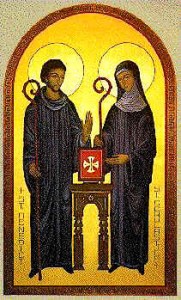Tomorrow, Friday 10 February, marks the Feast Day of St. Scholastica, a saint well recognised by both the Roman Catholic and Eastern Orthodox Churches, though if my own experience is anything to go by, I would humbly suggest that she is not very well known among the lay-people of the Church – the parishioners connected with, or served by monk-priests of the Order of St. Benedict – perhaps, proving the exception to this opening suggestion. Indeed, not much is known about her life – even from officialdom – and the little that is known comes almost exclusively from the writings (‘Dialogues’) of St. Gregory the Great, (Pope Gregory the Great 590 – 604).
 |
St. Benedict and St. Scholastica
(St. Scholastica is often depicted in art as a habited nun,
holding a crozier and crucifix, with her brother)
It is thought that she lived from around the year 480 until 543 / 547. Born in Italy, she was the twin sister of St. Benedict of Nursia; from an early stage in her youth, she led a life dedicated and consecrated to God, the one other dedication in her life being to that of her brother. cheap fake rolex watches
St. Gregory, in his ‘Dialogues’, tells us that after Benedict established his famous monastery at Monte Casino, she became a nun and leader of a community for women at Plombariola, about five miles from Benedict’s abbey. We do not know, for certain, what rule this community followed, although it seems most likely it was the Rule of St. Benedict. Thus she is regarded as the first Benedictine nun.
Scholastica was in the habit of meeting with her brother once each year. Because she was not allowed to visit the monastery, it was usual for the two to meet in a house not far from the grounds of the monastery, and oftentimes, Benedict was accompanied by one of two of his brethren. At such meetings, brother and sister would converse on spiritual matters, in prayer and pious conversation, discussing sacred texts and similar issues. In the evening, and before taking their leave of each other, they would most often reflect on what had taken place between them. On one occasion – only later to be proved their last meeting – Scholastica pleaded with her brother to stay the night and return to his monastery the following day. Benedict explained that it was impossible for him to be absent from his cell for the night, and, at this, Scholastica joined her hands and bowed down her head in prayer to God. At once, there came a tremendous thunderstorm accompanied by torrential rain, so furious in its impact, that Benedict and his companions were prevented from leaving.
At this Benedict exclaimed: “May Almighty God forgive you, sister, for what you have done.” Scolastica replied simply: “I asked a favour of you, and you refused to grant it. I asked it of God, and He has granted it!” They spent the night in spiritual conference. The next morning, they parted to meet no more on earth, for Benedict returned to his monastery and soon afterwards, saw a vision of Scholastica’s soul departing her body, ascending to heaven in the form of a dove. She was to die three days later.
Benedict arranged for the body of his sister to be placed in the tomb he had prepared for himself. He also arranged for his own to be placed there after his death. Saint Gregory says, “so death did not separate the bodies of these two, whose minds had ever been united in the Lord.”
Though we know little of St. Scholastica’s life, there is no reason to doubt the veracity of the little we know from the writings of St. Gregory, certainly as to the manner of her relationship with her brother, the manner of her calling – a life dedicated to God – the manner of her last meeting with St. Benedict, and finally, the manner of her passing from this life on earth.
There are, however, one or two comments I think it appropriate to make.
- St. Scholastica knew in her heart that on the occasion of their last meeting, she would not see her brother again, on this earth. This was why she asked him to stay so that they could finalise their discussions.
- St. Benedict had no inclination that he would not see his sister alive again.
- St. Scholastica’s plea to St. Benedict fell on ‘deaf ears’ and she then turned to God, who heard her prayer and granted it – at once.
- As to prayer, St. Scholastica gives us the example of what our prayers to God can achieve – not just the trivial, the banal or the momentous – but in everything that matters to us – for God wishes us to be happy and nothing is too little, or too great, for him to grant. We can always turn to him and say ‘sorry’ for our transgressions; but, we can also turn to him with our hopes and our dreams, those things nearest to our hearts.
 |
The image of St. Scholastica was depicted with that of St. Benedict on one side of the 2002 Austrian €50 coin, commemorating the ‘Christian Religious Orders’.
St. Scholastica is sometimes shown, in art, as receiving her veil from Saint Benedict, as in death, her soul departing her body like a dove; or kneeling before Saint Benedict’s cell. She is the patroness of Monte Casino and of all the Cassinese communities, and is often invoked as protection against storms and rain. replica breitling
Saint Scholastica – Pray for Us.
Socius
In circulating the blog by MailPress, the original formatting will inevitably be lost. To read the blog in its formatted state please go to the main blog site.
